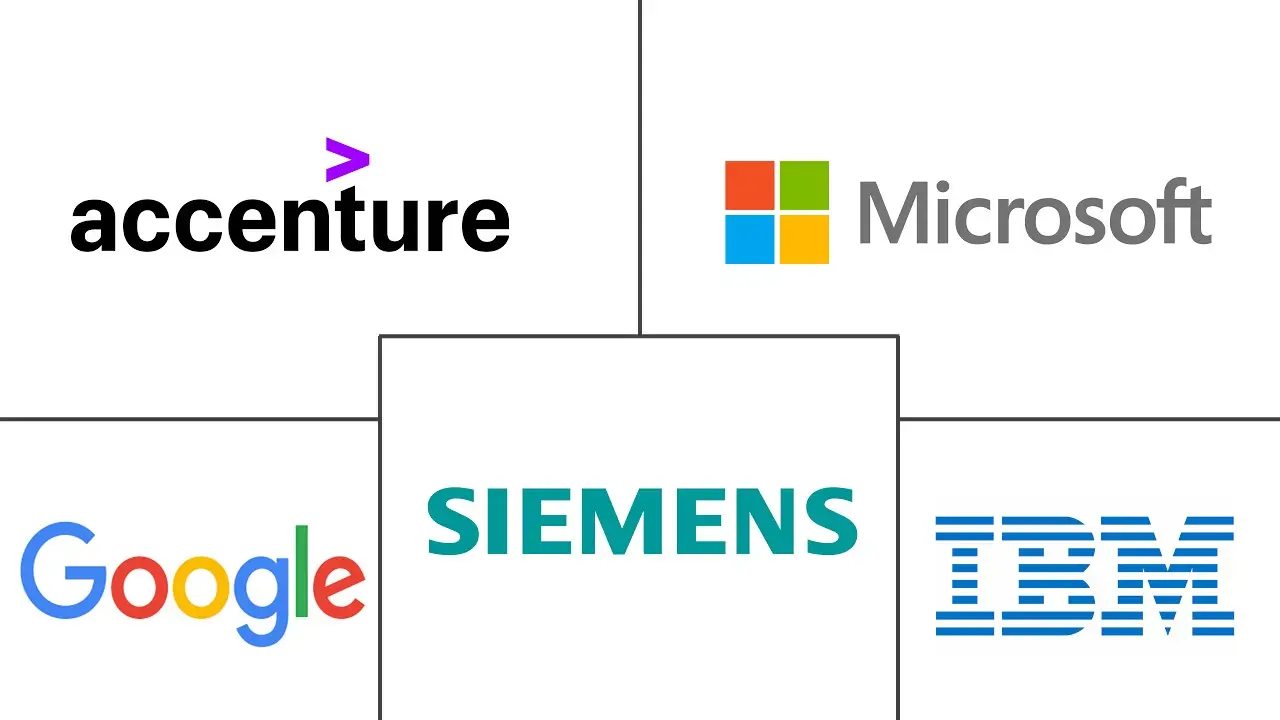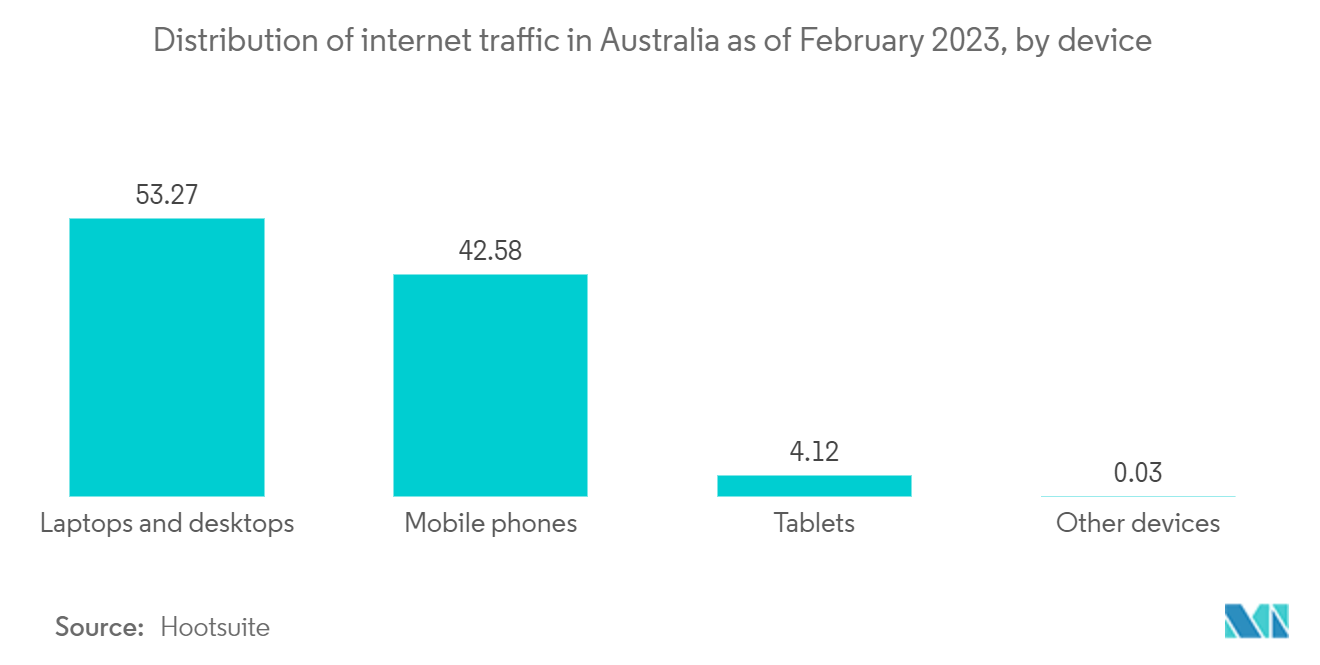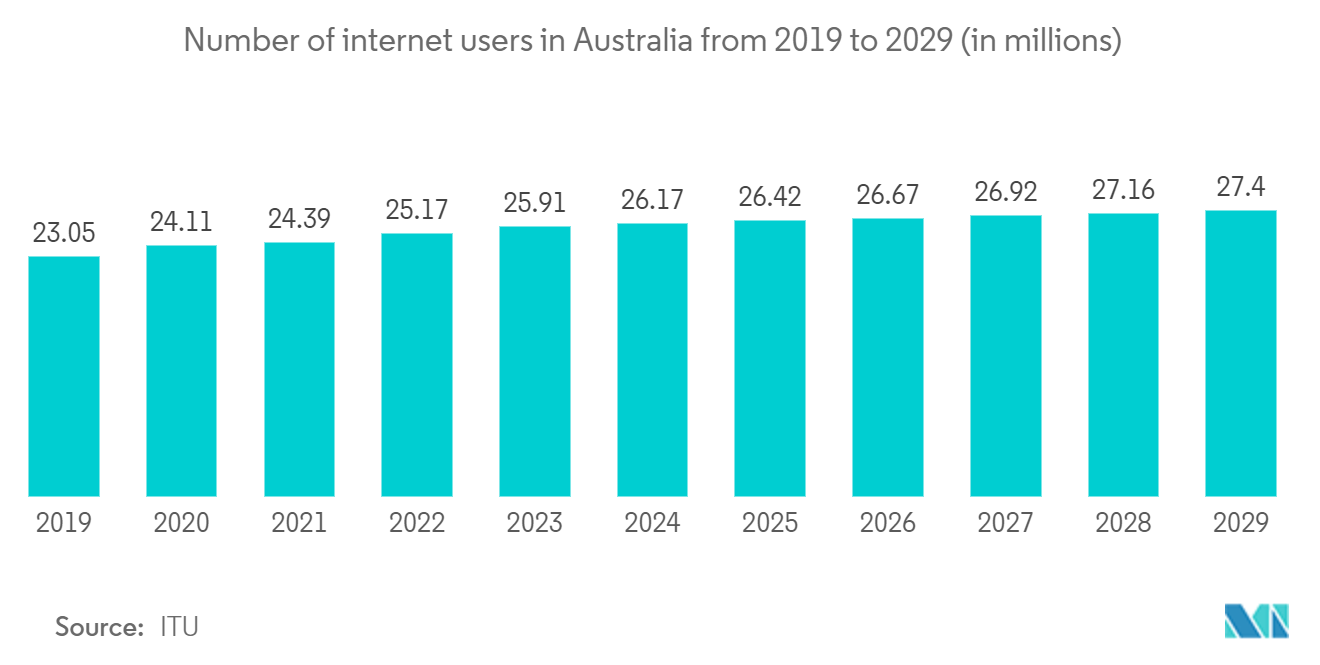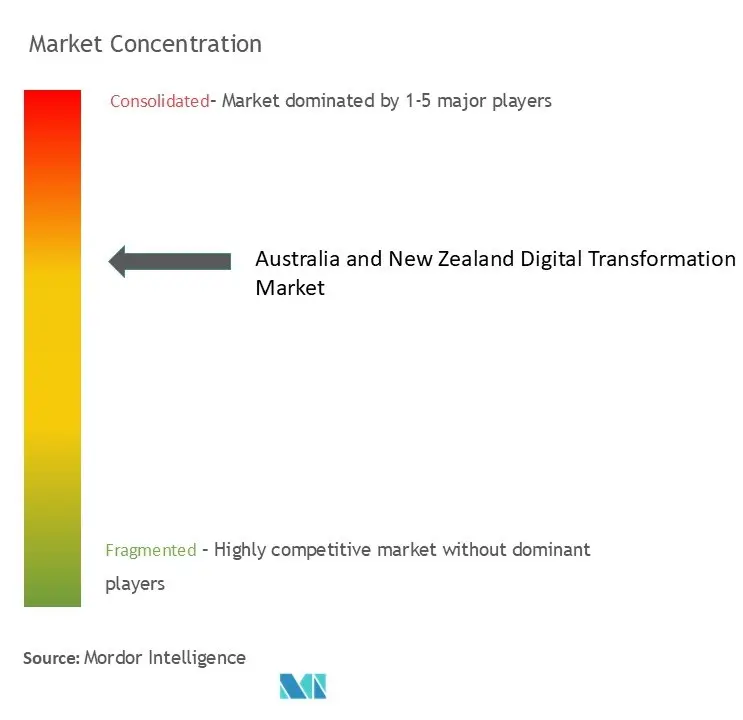Australia And New Zealand Digital Transformation Market Size

| Study Period | 2019 - 2029 |
| Base Year For Estimation | 2023 |
| Market Size (2024) | USD 29.62 Billion |
| Market Size (2029) | USD 96.84 Billion |
| CAGR (2024 - 2029) | 26.74 % |
| Market Concentration | Low |
Major Players
*Disclaimer: Major Players sorted in no particular order |
Australia And New Zealand Digital Transformation Market Analysis
The Australia And New Zealand Digital Transformation Market size is estimated at USD 29.62 billion in 2024, and is expected to reach USD 96.84 billion by 2029, growing at a CAGR of 26.74% during the forecast period (2024-2029).
- Recognizing the pivotal role of digital transformation in driving economic growth and enhancing competitiveness, both Australia and New Zealand have taken proactive measures. The Australian Government, acknowledging the transformative potential of advanced technologies like robotics, allocated a substantial USD 15 billion to the National Reconstruction Fund (NRF). This fund aims to rejuvenate Australia's industries, broaden market opportunities, and strengthen the national economy.
- In tandem with the NRF, the government's Industry Growth Program (IGP) has been instrumental in supporting small and medium-sized enterprises (SMEs) and startups, particularly during their formative stages. The 'Future Made in Australia' initiative also focuses on modernizing industries, reinforcing the manufacturing base, and improving onshore supply chains through targeted investments.
- In 2023, Australia emerged as a global leader in robotics and related research, securing a spot among the top 10 nations worldwide. The country achieved notable rankings: 4th in additive manufacturing, 5th in data analytics and autonomous underwater vehicles, 6th in autonomous systems operation technology, and 8th in advanced robotics (ASPI 2023). Furthermore, three Australian universities proudly claimed positions in the global top 50 for their significant contributions to robotics research (ASPI 2023).
- The National Critical Minerals Strategy 2023–2030 underscored the significance of diverse, resilient, and sustainable supply chains, aligning them with net-zero objectives and tapping into the economic potential of Australia's mineral resources. In alignment with the nation's Sovereign Defence Industrial Priorities, the Defence Industry Development Grant supported SMEs in acquiring new defence capabilities, achieving international accreditations, and fostering skills development. Meanwhile, the Australian Trade and Investment Commission worked diligently to enhance exports to pivotal markets and draw foreign investments, especially in robotics.
- The 2023–2030 Australian Cyber Security Strategy emphasized the importance of cybersecurity in internet-connected robotics. Regulatory frameworks were introduced for drone usage and automated vehicle operations on public roads to ensure safety and respect for privacy. With an eye on gender equality, the 'National Strategy to Achieve Gender Equality' aimed to position Australia as a worldwide leader in this domain. The 'Fee Free TAFE' initiative made waves with over 355,000 student enrollments, notably directing more than 10,900 students into the Technology and Digital Sector.
- However, a shortage of skilled professionals with expertise in digital technologies can hinder digital transformation efforts. Upskilling or retraining the existing workforce and attracting talent with the necessary skills can be challenging, especially in niche areas such as data analytics, artificial intelligence, and cybersecurity.
Australia And New Zealand Digital Transformation Market Trends
The IoT Segment is Expected to Occupy the Largest Market Share
- The growing adoption of IoT technology across end-user industries, such as manufacturing, automotive, and healthcare, is positively driving the market's growth. With the traditional manufacturing sector amid a digital transformation, IoT is fueling the next industrial revolution of intelligent connectivity. This is changing how industries approach increasingly complex processes of systems and machines to improve efficiency and reduce downtime.
- Industry 4.0 and IoT are central to new technological approaches for developing, producing, and managing the entire logistics chain, otherwise known as smart factory automation. Massive shifts in manufacturing due to Industry 4.0 and the acceptance of IoT require enterprises to adopt agile, smarter, and innovative ways to advance production with technologies that complement and augment human labor with robotics and reduce industrial accidents caused by process failure.
- With the high rate of adoption of connected devices and sensors and the enabling of M2M communication, there has been a surge in data points generated in the manufacturing industry. These data points can be of various kinds, ranging from a metric describing the time taken for the material to pass through one process cycle to a more advanced one, such as calculating the material stress capability in the automotive industry.
- The advancements in field devices, sensors, and robots are expected to expand the market scope further. IoT technologies are overcoming the labor shortage in the manufacturing sector. For more and more organizations, using Industry 4.0 technologies, like robotization, is part of day-to-day operations.
- The global IoT demand trend is expected to shift toward the industrial space from consumer demand over the coming years, with sheer volume demand driven by various Industry 4.0 applications. A significant share of the demand is expected to drive the manufacturing industries, energy, business mobility, healthcare, and supply chain.
- Moreover, smart city initiatives are expected to spearhead IoT growth over the coming years. IoT devices and systems are expected to increase as part of transportation, utilities, and infrastructure. Government initiatives and drives in line with this are expected to boost the adoption rates.

Telecom and IT to Witness Major Growth
- These countries rank among the largest IT and telecom markets, witnessing a surge in demand for faster and more seamless connectivity. The segment's expansion is driven by the rising adoption of mobile broadband services, significant investments in high-speed networks, and emerging opportunities for network and equipment vendors.
- Focusing on bolstering digital infrastructure and network connectivity, the 'Better Connectivity Plan' prioritized regional and rural areas of Australia. Meanwhile, the 'TAFE Technology Fund' allocated a USD 50 million investment to upgrade IT infrastructure, workshops, and laboratories across TAFEs nationwide.
- The Australian government overhauls its telecommunications industry to foster competition and ensure broadband services reach every Australian, especially those in regional, rural, and remote locales. The government asserts that every Australian, regardless of their location, will enjoy reliable high-speed broadband. All regions in Australia are mandated to have access to superfast broadband, defined as speeds of 25 Megabits per second (Mbps) or higher, as per the Statutory Infrastructure Provider (SIP) obligations. NBN Co Limited (NBN Co) is tasked with connecting properties and offering wholesale broadband services upon valid requests. As NBN Co broadens its network, it assumes the SIP role in those regions, and subsequently, by default, for the entirety of Australia.
- The IT sector spearheads most digital transformation initiatives, taking charge of both ownership and implementation. With rising automation and AI, there's a marked enhancement in customer service and a shift towards higher-value labor. Moreover, intelligent workflows streamline operations and boost productivity while empowering employees to make more informed decisions.
- Digital transformation, in light of evolving competitive threats, market dynamics, and shifting customer expectations, melds technology with best practices. This integration paves the way for accelerated product development, enriched customer experiences, and innovative business models.

Australia And New Zealand Digital Transformation Industry Overview
Australia And New Zealand Digital Transformation Market is semi-consolidated, with major players like Accenture PLC, Google LLC (Alphabet Inc.), Siemens AG, IBM Corporation, and Microsoft Corporation. Players in the market are adopting strategies such as partnerships, mergers, innovations, and acquisitions to enhance their product offerings and gain sustainable competitive advantage.
- June 2024: Google Australia introduced a novel initiative, an AI-centric accelerator program, tailored for Australian entrepreneurs. This 10-week program was distinct in that it was 'equity-free,' specifically designed for seed and series A stage Australian startups. These startups focused on developing platforms and products driven by AI and machine learning technologies.
- May 2024: Accenture has acquired The Lumery, a Melbourne-based consultancy specializing in marketing technology (martech). The Lumery aids top-tier organizations in crafting seamless customer experiences and evolving their marketing services. This acquisition bolsters the marketing transformation prowess of Accenture Song, Accenture's tech-driven creative division. Moreover, it enriches Accenture's Australian portfolio with enhanced services, including personalization, CRM and loyalty programs, testing and experimentation, and automation.
Australia And New Zealand Digital Transformation Market Leaders
-
Accenture PLC
-
Google LLC (Alphabet Inc.)
-
Siemens AG
-
IBM Corporation
-
Microsoft Corporation
*Disclaimer: Major Players sorted in no particular order

Australia And New Zealand Digital Transformation Market News
- June 2024: Tompkins Robotics announced that Primary Sight, a provider of supply chain technology solutions in Australia, became Tompkins Robotics ANZ. Bringing Primary Sight into the Tompkins Robotics organization marked a significant milestone as it continued to expand its global footprint and enhance its service offerings.
- May 2024: The state government allocated USD 6 million to the University of Adelaide's Australian Institute for Machine Learning (AIML). This funding aimed to bolster AIML's initiatives, particularly in enhancing domestic artificial intelligence (AI) capabilities. With this financial injection, AIML planned to not only grow its industrial AI program but also to assist small and medium enterprises (SMEs) in crafting AI-driven offerings. Additionally, the funds facilitated the recruitment of top-tier talent to the state.
Australia And New Zealand Digital Transformation Market Report - Table of Contents
1. INTRODUCTION
1.1 Study Assumptions and Market Definition
1.2 Scope of the Study
2. RESEARCH METHODOLOGY
3. EXECUTIVE SUMMARY
4. INDUSTRY ECOSYSTEM ANALYSIS (Detailed Coverage of Key Stakeholders in Digital Transformation Industry Product/Solution Providers, System Integrators/VARs, Connectivity Providers, Regulatory Bodies, End-users, Service Providers, etc.)
5. MARKET DYNAMICS
5.1 Market Drivers
5.1.1 Increase in the adoption of big data analytics and other technologies in Australia And New Zealand
5.1.2 The rapid proliferation of mobile devices and apps
5.2 Market Restraints
5.2.1 Concerns about the Privacy and Security of Information
6. CURRENT MARKET SCENARIO AND EVOLUTION OF DIGITAL TRANSFORMATION PRACTICES
7. KEY METRICS
7.1 Technology Spending Trends
7.2 Number of IoT Devices
7.3 Total Cyberattacks
7.4 Technology Staffing Trends
7.5 Internet growth and penetration in Australia And New Zealand
7.6 Digital Competitiveness Ranking
7.7 fixed and mobile broadband cove
7.8 Cloud adoption
7.9 AI adoption
7.10 E-commerce penetration
8. 8. MARKET SEGMENTATION
8.1 By Type
8.1.1 Analytics, Artificial Intelligence and Machine Learning
8.1.1.1 Current Market Scenario and Market Projections for the Forecast Period
8.1.1.2 Key Growth Influencers (Drivers, Challenges, and Opportunities)
8.1.1.3 Use Case Analysis
8.1.1.4 Market Outlook
8.1.2 Extended Reality (XR)
8.1.2.1 Current Market Scenario and Market Projections for the Forecast Period
8.1.2.2 Key Growth Influencers (Drivers, Challenges, and Opportunities)
8.1.2.3 Use Case Analysis
8.1.2.4 Market Outlook
8.1.3 IoT
8.1.3.1 Current Market Scenario and Market Projections for the Forecast Period
8.1.3.2 Key Growth Influencers (Drivers, Challenges, and Opportunities)
8.1.3.3 Use Case Analysis
8.1.3.4 Market Outlook
8.1.4 Industrial Robotics
8.1.4.1 Current Market Scenario and Market Projections for the Forecast Period
8.1.4.2 Key Growth Influencers (Drivers, Challenges, and Opportunities)
8.1.4.3 Use Case Analysis
8.1.4.4 Market Outlook
8.1.5 Blockchain
8.1.5.1 Current Market Scenario and Market Projections for the Forecast Period
8.1.5.2 Key Growth Influencers (Drivers, Challenges, and Opportunities)
8.1.5.3 Market Outlook
8.1.6 Additive Manufacturing/3D Printing
8.1.6.1 Current Market Scenario and Market Projections for the Forecast Period
8.1.6.2 Key Growth Influencers (Drivers, Challenges, and Opportunities)
8.1.6.3 Use Case Analysis
8.1.6.4 Market Outlook
8.1.7 Cybersecurity
8.1.7.1 Current Market Scenario and Market Projections for the Forecast Period
8.1.7.2 Key Growth Influencers (Drivers, Challenges, and Opportunities)
8.1.7.3 Use Case Analysis
8.1.7.4 Market Outlook
8.1.8 Cloud and Edge Computing
8.1.8.1 Current Market Scenario and Market Projections for the Forecast Period
8.1.8.2 Key Growth Influencers (Drivers, Challenges, and Opportunities)
8.1.8.3 Use Case Analysis
8.1.8.4 Market Outlook
8.1.9 Others (digital twin, mobility and connectivity)
8.1.9.1 Current Market Scenario and Market Projections for the Forecast Period
8.1.9.2 Key Growth Influencers (Drivers, Challenges, and Opportunities)
8.1.9.3 Market Breakdown by Type (Digital Twin, Mobility and Connectivi
8.1.9.4 Use Case Analysis
8.1.9.5 Market Outlook
8.2 By End-User Industry
8.2.1 Manufacturing
8.2.1.1 Oil, Gas and Utilities
8.2.1.2 Retail & e-commerce
8.2.1.3 Transportation and Logistics
8.2.1.4 Healthcare
8.2.1.5 BFSI
8.2.1.6 Telecom and IT
8.2.1.7 Government and Public Sector
8.2.1.8 Others (Education, Media &
9. COMPETITIVE LANDSCAPE
9.1 Company Profiles
9.1.1 Accenture PLC
9.1.2 Google LLC (Alphabet Inc.)
9.1.3 Siemens AG
9.1.4 IBM Corporation
9.1.5 Microsoft Corporation
9.1.6 Cognex Corporation
9.1.7 Hewlett Packard Enterprise
9.1.8 SAP SE
9.1.9 EMC Corporation (Dell EMC)
9.1.10 Oracle Corporation
9.1.11 Adobe Inc.
9.1.12 Amazon Web Services Inc.
9.1.13 Apple Inc.
9.1.14 Salesforce.com Inc.
9.1.15 Cisco Systems Inc.
- *List Not Exhaustive
10. KEY TRANSFORMATIVE TECHNOLOGIES
10.1 Quantum Computing
10.2 Manufacturing as a Service (MaaS)
10.3 Cognitive Process Automation
10.4 Nanotechnology
Australia And New Zealand Digital Transformation Industry Segmentation
Digital transformation is the process of incorporating digital technologies such as artificial intelligence and machine learning, extended reality (VR & AR) for industrial applications, IoT, industrial robotics, blockchain, digital twins, 3D printing/ additive manufacturing, industrial cyber security, wireless connectivity, edge computing, smart mobility, and others across various end-user industries.
Australia And New Zealand Digital Transformation market is segmented by type (analytics, artificial intelligence, and machine learning extended reality (XR), IoT, industrial robotics, blockchain, additive manufacturing/3D printing, cybersecurity, cloud and edge, computing, and others (digital twin, mobility, and connectivity), by end-users (manufacturing, oil, gas, and utilities, retail & e-commerce, transportation, and logistics, healthcare, BFSI, telecom, and IT, government and public sector, Others (education, media & entertainment, environment etc). The market sizes and forecasts are provided in terms of value in USD for all the above segments.
| By Type | |||||||
| |||||||
| |||||||
| |||||||
| |||||||
| |||||||
| |||||||
| |||||||
| |||||||
|
| By End-User Industry | ||||||||||
|
Australia And New Zealand Digital Transformation Market Research FAQs
How big is the Australia And New Zealand Digital Transformation Market?
The Australia And New Zealand Digital Transformation Market size is expected to reach USD 29.62 billion in 2024 and grow at a CAGR of 26.74% to reach USD 96.84 billion by 2029.
What is the current Australia And New Zealand Digital Transformation Market size?
In 2024, the Australia And New Zealand Digital Transformation Market size is expected to reach USD 29.62 billion.
Who are the key players in Australia And New Zealand Digital Transformation Market?
Accenture PLC, Google LLC (Alphabet Inc.), Siemens AG, IBM Corporation and Microsoft Corporation are the major companies operating in the Australia And New Zealand Digital Transformation Market.
What years does this Australia And New Zealand Digital Transformation Market cover, and what was the market size in 2023?
In 2023, the Australia And New Zealand Digital Transformation Market size was estimated at USD 21.70 billion. The report covers the Australia And New Zealand Digital Transformation Market historical market size for years: 2019, 2020, 2021, 2022 and 2023. The report also forecasts the Australia And New Zealand Digital Transformation Market size for years: 2024, 2025, 2026, 2027, 2028 and 2029.
Australia And New Zealand Digital Transformation Industry Report
Statistics for the 2024 Australia And New Zealand Digital Transformation market share, size and revenue growth rate, created by Mordor Intelligence™ Industry Reports. Australia And New Zealand Digital Transformation analysis includes a market forecast outlook for 2024 to 2029) and historical overview. Get a sample of this industry analysis as a free report PDF download.



